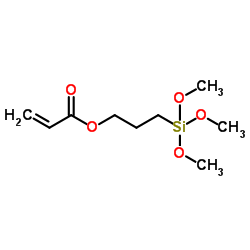3-acryloxypropyl trimethoxysilane

3-acryloxypropyl trimethoxysilane structure
|
Common Name | 3-acryloxypropyl trimethoxysilane | ||
|---|---|---|---|---|
| CAS Number | 4369-14-6 | Molecular Weight | 234.322 | |
| Density | 1.0±0.1 g/cm3 | Boiling Point | 240.0±23.0 °C at 760 mmHg | |
| Molecular Formula | C9H18O5Si | Melting Point | N/A | |
| MSDS | Chinese USA | Flash Point | 82.3±18.2 °C | |
| Symbol |


GHS05, GHS07 |
Signal Word | Danger | |
|
Biomimetic microfingerprints for anti-counterfeiting strategies.
Adv. Mater. 27(12) , 2083-9, (2015) An unclonable, fingerprint-mimicking anti-counterfeiting strategy is presented that encrypts polymeric particles with randomly generated silica film wrinkles. The generated wrinkle codes are as highly unique as human fingerprints and are technically irreprodu... |
|
|
The effect of five silane coupling agents on the bond strength of a luting cement to a silica-coated titanium.
Dent. Mater. 23(9) , 1173-80, (2007) The adhesive performance of five silane coupling agents in adhering resin composite cement (3M ESPE) to silica-coated titanium was evaluated. Titanium was tribochemically silica-coated by using the Rocatec system.Two volume percent solutions of 3-acryloyloxyp... |
|
|
Hydrolytic stability of silanated zirconia-silica-urethane dimethacrylate composites.
J. Oral Rehabil. 22(3) , 213-20, (1995) The effect of the method of silanation of zirconia-silica by 3-methacryloxypropyltrimethoxysilane (MAPM) and 3-acryloxypropyltrimethoxysilane (APM) on the diametral tensile and transverse strength of composites made from these silanated fillers and a urethane... |
|
|
The use of glass substrates with bi-functional silanes for designing micropatterned cell-secreted cytokine immunoassays.
Biomaterials 32(23) , 5478-88, (2011) It is often desirable to sequester cells in specific locations on the surface and to integrate sensing elements next to the cells. In the present study, surfaces were fabricated so as to position cytokine sensing domains inside non-fouling poly(ethylene glyco... |
|
|
Effect of the cross-linking silane concentration in a novel silane system on bonding resin-composite cement.
Acta Odontol. Scand. 66(4) , 250-5, (2008) Four experimental blends of an organo-functional silane monomer with a non-functional cross-linking silane monomer (a novel silane system) were evaluated as adhesion promoters in an experiment in which a resin-composite cement was bonded to silica-coated tita... |
|
|
Enhanced resin-composite bonding to zirconia framework after pretreatment with selected silane monomers.
Dent. Mater. 27(3) , 273-80, (2011) To evaluate the effect of five experimental silane monomer primers in vitro on the shear bond strength of a phosphate ester resin-composite cement bonded to a silicatized zirconia framework.A total of 144 planar zirconia (Procera AllZircon) specimens were sub... |
|
|
Flexural strength of experimentally filled resins made of electron beam irradiated silica fillers.
J. Mech. Behav. Biomed. Mater. 2(1) , 61-4, (2009) This study investigated the influence of different silica fillers on the flexural strength of experimentally filled resins. Hydrophilic (non-silanated) silica, hydrophobic silica modified by organofunctional silane, and silica modified by organofunctional sil... |
|
|
The effects of different additives on the dielectric relaxation and the dynamic mechanical properties of urethane dimethacrylate.
J. Oral Rehabil. 27(3) , 250-68, (2000) The polymer-filler interaction of a dental composite was examined by dielectric measurements to determine how a non-compatible inorganic phase modifies the molecular behaviour of the polymer chains and how modification of this phase by silanation can affect t... |
|
|
Improved brushing durability of titanium dioxide coating on polymethylmethacrylate substrate by prior treatment with acryloxypropyl trimethoxysilane-based agent for denture application.
Dent. Mater. J. 29(1) , 97-103, (2010) The purpose of this study was to determine whether the brushing durability of a titanium dioxide coating on a polymethyl methacrylate (PMMA) substrate was improved by prior treatment with an acryloxypropyl trimethoxysilane-based agent. Titanium dioxide coatin... |